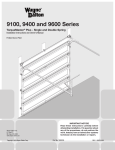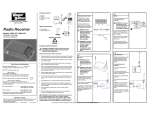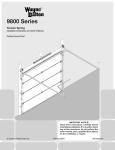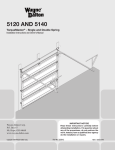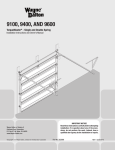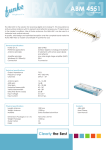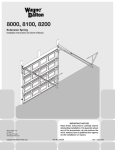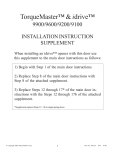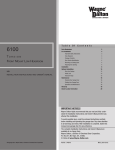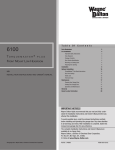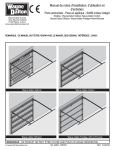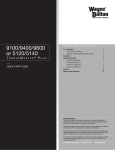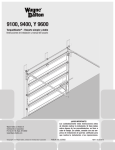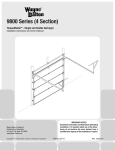Download Wayne-Dalton 8000 Windload User's Manual
Transcript
8000, 8100, 8200 WINDLOAD Torsion Spring Installation Instructions and Owner’s Manual Wayne-Dalton Corp. P.O. Box 67 Mt. Hope, OH 44660 www.Wayne-Dalton.com ©Copyright 2011 Wayne-Dalton, a Division of Overhead Door Corporation IMPORTANT NOTICE! Read these instructions carefully before attempting installation. If in question about any of the procedures, do not perform the work. Instead, have a trained door systems technician do the installation or repairs. Part No. 335486 REV4 08/18/2011 Table of Contents Important Safety Instructions............................................. 2 Package Contents...........................................................3-4 Door Section Identification................................................. 4 Tools Required................................................................... 5 Pre-Installation...............................................................5-6 Removing The Old Door..................................... 5 Preparing The Opening...................................... 6 Installation . .................................................................7-25 Optional Installations..................................................26-27 Side Lock........................................................ 26 Pull Rope......................................................... 26 Trolley Operator............................................... 27 Maintenance...............................................................28-29 Cleaning.......................................................... 28 Painting Instructions........................................ 29 Warranty.......................................................................... 30 Dealer Locator Information.............................................. 30 Definition of key words used in this manual: WARNING Indicates a potentially hazardous situation which, if not avoided, could result in severe or fatal injury. CAUTION: PROPERTY DAMAGE OR INJURY CAN RESULT FROM FAILURE TO FOLLOW INSTRUCTIONS. IMPORTANT: Required step for safe and proper door operation. NOTE: Information assuring proper installation of the door. WARNING To avoid Possible injury, Read these instructions carefully before attempting installation. If in question about any of the procedures, do not perform the work. Instead, have a trained door systems technician do the installation or repairs. 1. 2. 3. 4. 5. 6. 7. 8. 9. 10. 11. 12. 13. 14. 15. 16. Read and follow all installation instructions. Wear protective gloves during installation to avoid possible cuts from sharp metal edges. It is always recommended to wear eye protection when using tools, otherwise eye injury could result. Avoid installing your new door on windy days. Door could fall during the installation causing severe or fatal injury. Doors 12’- 0” wide and wider should be installed by two persons, to avoid possible injury. Operate door ONLY when it is properly adjusted and free from obstructions. If a door becomes hard to operate, inoperative or is damaged, immediately have necessary adjustments and/or repairs made by a trained door system technician using proper tools and instructions. DO NOT stand or walk under a moving door, or permit anybody to stand or walk under an electrically operated door. DO NOT place fingers or hands into open section joints when closing a door. Use lift handles/gripping points when operating door manually. DO NOT permit children to operate garage door or door controls. Severe or fatal injury could result, should the child become entrapped between the door and the floor. Due to constant extreme spring tension, DO NOT attempt any adjustment, repair or alteration to any part of the door, especially to springs, spring brackets, bottom corner brackets, red colored fasteners, cables or supports. To avoid possible severe or fatal injury, have any such work performed by a trained door systems technician using proper tools and instructions. On electrically operated doors, pull down ropes must be removed and locks must be removed or made inoperative in the open (unlocked) position. Top section of door may need to be reinforced when attaching an electric opener. Check door and/or opener manufacturer’s instructions. VISUALLY inspect door and hardware monthly for worn and or broken parts. Check to ensure door operates freely. Test electric opener’s safety features monthly, following opener manufacturer’s instructions. NEVER hang tools, bicycles, hoses, clothing or anything else from horizontal tracks. Track systems are not intended or designed to support extra weight. After installation is complete, fasten this manual near garage door. 2 Please Do Not Return This Product To The Store. Contact your local Wayne-Dalton dealer. To find your local Wayne-Dalton dealer, refer to your local yellow pages business listings or go to the Find a Dealer section online at www.Wayne-Dalton.com Package Contents NOTE: Depending on the door model, some parts listed will not be supplied if not necessary. Rear supports may or may not be included with your door. Horizontal angles RH/LH (as required) Door sections (as required) (1) Torsion tube (2) Quick Install RH/LH flagangles (2) Horizontal tracks RH/LH (2) Fully adjustable RH/LH flagangles 1 U-Bar’s (as required) Top bracket assemblies (as required) Weather seal & nails (if included) Left and right bottom brackets (as required) (1) Center bracket End bearing bracket (2) Step plates #6 Screw eye and pull rope (if included) #1, #2, #3 and #4 Wide hinges (as required) Top bracket assemblies (as required) Extension brackets (as required) (1) Center bracket bushing (2) Lift handles & spacers Long and short stem rollers (as required) Right & left torsion springs (as required) (1) Windload label Q.I. jamb brackets (as required) (2) Roller Spacers Right and left counterbalance cables Right & left Drums #1, #2, #3 and #4 Narrow hinges (as required) (2) Vertical RH/LH tracks Left and right bottom brackets (as required) Slotted jamb brackets (as required) Pushnuts (as required) 3 Please Do Not Return This Product To The Store. Contact your local Wayne-Dalton dealer. To find your local Wayne-Dalton dealer, refer to your local yellow pages business listings or go to the Find a Dealer section online at www.Wayne-Dalton.com Package Contents Continued... (2) 1/4”- 20 Hex nuts 1/4”- 20 Flange hex nuts (as required) 5/16” x 1 5/8” Hex head lag screws (as required) (2) 3/8”- 16 Hex nuts 5/16”- 18 Hex nuts (as required) 1/4”- 20 x 9/16” track Bolts (as required) 5/16” x 1 5/8” tamper resistant Lag Screw (as required) Cotter pins (as required) (2) 3/8”- 16 x 1-1/2” hex Head Bolts (2) 1/4” x 2- 1/2” carriage bolts (2) 3/8” - 16 x 3/4” Truss head bolts 1/4” - 14 x 7/8” Self drilling screws (as required) Clevis pins (as required) (2) 1/4”- 20 X 5/8” Tamper resistant screws 5/16” Washers (as required) 5/16” x 2” tamper-resistant Hex Head Lag Screws (as required) (2) 1/4” x 2-3/4” carriage bolts Stud plates (as required) Door Section Identification Door Height Bottom Lock (second) Intermediate (third) Intermediate II (fourth) Top 6’0” 18” 18” 18” NA 18” 6’6” 21” 18” 18” NA 21” 7’0” 21” 21” 21” NA 21” 7’6” 18” 18” 18” 18” 18” 8’0” 21” 18” 18” 18” 21” Warning label 18” Or 21” When installing your door you must use sections of the appropriate height in the right stacking order. What sections heights you need to use in what order depends on the height of your door. Unless your door is five sections in height, you will not receive an Intermediate II section. Intermediate i Section The bottom section can be identified by the factory attached bottom astragal, or by the bottom bracket warning labels on each end stile. The intermediate i section may have a warning label attached to either right or left hand endstile of the section. This section is always the 3rd section from the bottom of the door. Astragal Bottom Bracket warning Labels Bottom Section 4 Please Do Not Return This Product To The Store. Contact your local Wayne-Dalton dealer. To find your local Wayne-Dalton dealer, refer to your local yellow pages business listings or go to the Find a Dealer section online at www.Wayne-Dalton.com Pencil Power drill Phillips head screwdriver Ratchet wrench 7/16”, 1/2” & 9/16” Socket 9/32”, 1/2”, 3/16” & 1/8” Drill bits Level Sawhorse Flat tip screwdriver Vice grips Safety glasses Tape measure 1/4” Torx bit PRE-INSTALLATION Tools Required Gloves 3/8”, 7/16” Socket driver Hammer 1/4”, 3/8”, 7/16”, 1/2” & 9/16” Wrenches Vice clamps Approved winding bars Step ladder Removing An Old Door IMPORTANT: Counterbalance SPRING TENSION Must always BE Released BEfORE any attempt IS Made TO Start Removing an EXISTING DOOR. WARNING A Powerful SPRING Releasing ITS Energy Suddenly Can Cause Severe OR fatal Injury. TO avoid Injury have a Trained DOOR Systems Technician, using PROPER TOOLS and Instructions, Release The SPRING TENSION. For detailed information see supplemental instructions “Removing an Existing Door /Preparing the Opening”. These instructions are available at no charge from WayneDalton, a Division of Overhead Door Corporation, P.O. Box 67, Mt. hope, Oh 44660, or at www.Wayne-Dalton.com. 5 Please Do Not Return This Product To The Store. Contact your local Wayne-Dalton dealer. To find your local Wayne-Dalton dealer, refer to your local yellow pages business listings or go to the Find a Dealer section online at www.Wayne-Dalton.com Preparing the Opening Tools Needed: Recommended tools from page 5 Suitable mounting surface 2” x 6” lumber minimum Header board 2” x 6” lumber recommended If you just removed your existing door or you are installing a new door, complete all steps in PREPARING THE OPENING. To ensure secure mounting of track brackets, side and center bearing brackets, or steel angles to new or retro-fit construction, it is recommended to follow the procedures outlined in DASMA Technical Data Sheets #156, #161 and #164 at www.dasma.com. Level header The inside perimeter of your garage door opening should be framed with wood jamb and header material. The jambs and header must be securely fastened to sound framing members. It is recommended that 2” x 6” lumber be used. The jambs must be plumb and the header level. The jambs should extend a minimum of 14” (356 mm) above the top of the opening for Torsion spring applications. For low headroom applications, the jambs should extend to the ceiling height. Minimum side clearance required, from the opening to the wall, is 3-1/2” (89 mm). Plumb jambs Door width IMPORTANT: Closely inspect existing jambs, header and mounting surface. Any wood found not to be sound, must be replaced. For Torsion spring applications, a suitable mounting surface must be firmly attached to the wall, above the header at the center of the opening. The mounting surface must be 2” x 6” lumber minimum (Select southern yellow pine lumber. Do not use lumber marked as spruce-pine-fur or SPF). The mounting surface must be securely attached to the wall with four (4) 3/8” anchors for masonry constructions or four (4) 5/16” x 4” lag screws for wood construction. Door height Headroom Bac kro Header om Jamb NOTE: Drill a 3/16” pilot hole in the mounting surface to avoid splitting the lumber. Do not attach the mounting surface with nails. Weather seal WARNING FAILURE TO SECURELY ATTACH A SUITABLE MOUNTING PAD TO STRUCTURALLY SOUND FRAMING MEMBER COULD CAUSE SPRINGS TO VIOLENTLY PULL MOUNTING PAD FROM WALL, RESULTING IN SEVERE OR FATAL INJURY. Jamb Weather Seal (May Not Be Included): Cut the weather seal if necessary to fit the header and jambs. For quick install track: Align the header seal with the inside edge of the header and temporarily secure it to the header with equally spaced nails. Next, fit the jamb seals up tight against the header seal and flush with the inside edge of the jamb. Temporarily secure the jamb seals with equally space nails. This will keep the bottom section from falling out of the opening during installation. Equally space nails approximately 12” to 18” apart. For fully adjustable track: Align the header seal 1/8” to 1/4” inside the header and temporarily secure it to the header with equally spaced nails. Next, fit the jamb seals up tight against the header seal and 1/8” to 1/4” inside the jamb. Temporarily secure the jamb seals with equally spaced nails. This will keep the bottom section from falling out of the opening during installation. Equally space nails approximately 12” to 18” apart. NOTE: Do not permanently attach weather seal to the jamb at this time. Weather seal Jamb Jamb Quick Install Track 1/8” to 1/4” Fully adjustable Track Headroom requirement TRACK TYPE Torsion Springs 12” Radius Track 12 1/2” 15” Radius Track 14-1/2” HEADROOM REQUIREMENT: Headroom is defined as the space needed above the top of the door for tracks, springs, etc. to allow the door to open properly. If the door is to be motor operated, 2-1/2” (64 mm) of additional headroom is required. BACKROOM REQUIREMENT: Backroom is defined as the distance needed from the opening back into the garage to allow the door to open fully. Weather seal Backroom requirement MANUAL MOTOR LIFT OPERATED DOOR HEIGHT TRACK 6’0”, 7’0” 12”, 15” Radius 98” 125” 7’6”, 8’0” 12”, 15” Radius 110” 137” 6 Please Do Not Return This Product To The Store. Contact your local Wayne-Dalton dealer. To find your local Wayne-Dalton dealer, refer to your local yellow pages business listings or go to the Find a Dealer section online at www.Wayne-Dalton.com Installation Begin the installation of the door by checking the opening. It must be the same size as the door. Vertical jambs must be plumb and level with header. Side clearance, from edge of door to wall, must be a minimum of 3-1/2” (89mm) on each side. IMPORTANT: Stainless STEEL OR PT 2000 Coated Lag SCREWS Must BE used When Installing CENTER Bearing Brackets, END Brackets, jamb Brackets, Operator Mounting/Support Brackets and DISCONNECT Brackets ON Treated Lumber (PRESERvaTIvE-TREaTED). Stainless STEEL OR PT 2000 Coated Lag SCREWS are NOT Necessary When Installing Products ON un-treated Lumber. NOTE: It is recommended that 5/16” lag screws be pilot drilled using a 3/16” drill bit, prior to fastening. NOTE: Use this manual in conjunction with the windload specification sheet provided with your door. Tools Needed: None Quick install tab unlocked Quick install tab locked NOTE: If you have fully adjustable flagangles, skip this step and complete Step 2. Place the lower quick install tab of the flagangle in the quick install feature of the vertical track. Give the flagangle 1/4 turn to lock in place. Repeat for other side. Flagangle Flagangle INSTALLATION 1 Attaching Quick Install Flag Angle to Vertical Track NOTE: After completing this step, continue with Step 3. Vertical track Vertical track Left hand track and flagangle 2 Tools Needed: None Fully adjustable flagangle Attaching Fully Adjustable Flagangle to Vertical Track Right hand track and flagangle (2) 1/4”- 20 x 9/16” Track bolts NOTE: If you have quick install flagangles, skip this step and complete Step 3. Attaching fully adjustable flagangle to universal vertical track: Hand tighten the flagangle to the vertical track using (2) 1/4” - 20 x 9/16” track bolts and (2) 1/4” - 20 flange hex nuts. Repeat for other side. Secure the flange nuts after flagangle spacing is complete (Step 16). Attaching fully adjustable flagangle to quick install vertical track: Hand tighten the flagangle to the vertical track using (1) stud plate and (2) 1/4” - 20 flange hex nuts. Repeat for other side. Universal vertical track (2) 1/4”- 20 Flange hex nuts (2) 1/4”- 20 Flange hex nuts Fully adjustable flagangle Secure the flange nuts after flagangle spacing is complete (Step 16). Quick install vertical track Stud plate 7 Please Do Not Return This Product To The Store. Contact your local Wayne-Dalton dealer. To find your local Wayne-Dalton dealer, refer to your local yellow pages business listings or go to the Find a Dealer section online at www.Wayne-Dalton.com 3 Tools Needed: Hammer Horizontal angle Tabs Horizontal Angle Position the horizontal angle as shown. Place tabs of horizontal angle in the key slot of horizontal track. Using a hammer, tap the horizontal angle towards the curved end of the track until the hole in track and angle are aligned. Set tracks aside. Hole Hole NOTE: For larger doors, a full length horizontal angle may be spot welded to the horizontal track. If the horizontal angle is not welded, the horizontal angle will be installed as shown. Key slots Horizontal track Horizontal track Horizontal angle Horizontal track Horizontal angle Tabs Key slots 4 Tools Needed: Tape Measure Installing JB-US Jamb Brackets (JB-US) JAMB BRACKET SCHEDULE DOOR HEIGHT NOTE: The following (JB-US) denotes a slotted jamb bracket. Measure the length or the vertical track. Using the jamb bracket schedule, determine the placement of the jamb brackets for your door height and track type. Loosely fasten the (JB-US) jamb bracket to the track with a 1/4”-20 x 9/16” track bolt and nut. Vertical track (JB-US) Jamb bracket (1) 1/4” 20 X 9/16” Track bolt (1) 1/4”- 20 Flange hex nut (JB-US) JAMB BRACKET INSTALLATION Horizontal track NO. OF SECTIONS NO. OF JAMB BRACKETS (EACH JAMB) LOCATION OF CENTER LINE OF JAMB BRACKETS MEASURED FROM BOTTOM OF TRACK (ALL DIMENSIONS ± 2”) WINDLOAD SPECIFICATION 1101, 1102, 1120, 1121, 1122, 1140, 1141, 1143 6’-0” 4 1 33 1/2” (JB-US) 6’-6’’ 4 2 34” (JB-US), 56” (JB-US) 7’-0’’ 4 2 29 1/2” (JB-US), 63 1/4” (JB-US) 7’-6’’ 5 1 28 1/2” (JB-US) 8’-0’’ 5 2 34” (JB-US), 58” (JB-US) WINDLOAD SPECIFICATION 1123 6’-0” 4 2 2” (JB-US), 23” (JB-US), 33 1/2” (JB-US) 6’-6’’ 4 3 2” (JB-US), 23 1/2” (JB-US), 34” (JB-US), 56” (JB-US) 7’-0’’ 4 4 2” (JB-US), 25 1/2” (JB-US), 34” (JB-US), 63 1/4” (JB-US) 7’-6’’ 5 4 2” (JB-US), 24 1/2” (JB-US), 32 1/2” (JB-US), 49” (JB-US) 8’-0’’ 5 5 2” (JB-US), 23” (JB-US), 34” (JB-US), 58” (JB-US), 75 1/2” (JB-US) WINDLOAD SPECIFICATION 1103, 1104, 1124, 1125, 1142, 1144 6’-6’’ 4 7 2” (JB-US), 10” (JB-US), 21 3/4” (JB-US), 29 3/4” (JBUS), 39” (JB-US), 48” (JB-US), 57 1/4” (JB-US) 7’-0’’ 4 7 2” (JB-US), 10” (JB-US), 21 3/4” (JB-US), 29 3/4” (JBUS), 42” (JB-US), 52 1/2” (JB-US), 63 1/4” (JB-US) 7’-6’’ 5 8 2” (JB-US), 10” (JB-US), 18 3/4” (JB-US), 26 3/4” (JB-US), 36” (JB-US), 45” (JB-US), 54 1/4” (JB-US), 74 1/2” (JB-US) 8’-0’’ 5 8 2” (JB-US), 10” (JB-US), 21 3/4” (JB-US), 29 3/4” (JB-US), 39” (JB-US), 48” (JB-US), 57 1/2” (JB-US), 75 1/2” (JB-US) 8 Please Do Not Return This Product To The Store. Contact your local Wayne-Dalton dealer. To find your local Wayne-Dalton dealer, refer to your local yellow pages business listings or go to the Find a Dealer section online at www.Wayne-Dalton.com 5 Tools Needed: Tape Measure Installing Q.I. Jamb Brackets NOTE: The following (Q.I.) denotes a quick install jamb bracket. No additional hardware is needed. Measure the length or the vertical track. Using the jamb bracket schedule, determine the placement of the jamb brackets for your door height and track type. Align the twistlock tab on (Q.I.) jamb bracket with the quick install feature in the track and turn the jamb bracket perpendicular to the track so the mounting flange is toward the back leg of the track. Twist lock tabs Q.I. JAMB BRACKET SCHEDULE WINDLOAD SPECIFICATION 1100, 1101, 1102, 1120, 1121, 1122, 1123, 1140, 1141, 1143 DOOR HEIGHT 1ST SET 2ND SET 3RD SET JAMB BKT POSITION JAMB BKT POSITION JAMB BKT POSITION 6’0” (4 SECTIONS) QIJB - 9 Middle QIJB - 11 Middle Not applicable 6’6” (4 SECTIONS) QIJB - 9 Middle QIJB - 10 Bottom Not applicable 7’0” (4 SECTIONS) QIJB - 9 Middle QIJB - 10 Bottom Not applicable 7’6” (5 SECTIONS) QIJB - 9 Top QIJB - 10 Middle QIJB - 11 Middle 8’0” (5 SECTIONS) QIJB - 9 Top QIJB - 10 Middle QIJB - 11 Middle Top hole INSTALLATION Middle hole Bottom hole Q.I. jamb bracket Q.i. jamb bracket 6 Tools Needed: Power Drill 7/16” Socket Driver 1/4” Torx bit Needle Nose Pliers Left side shown Quick install feature (Q.I.) JAMB BRACKET INSTALLATION U-Bar Schedule Bottom Bracket NOTE: For door section identification see page 4. IMPORTANT: Right and left hand is always determined from inside the garage looking out. Refer to the u-bar schedule to determine if the bottom section requires a u-bar. If the bottom section requires a u-bar, position the u-bar over the bottom brackets and center the u-bar side to side on the bottom section. Door Height Section Position of u-bar on section Windload Option Codes: 1104 / 1123 / 1124 / 1125 /1142 / 1143 / 1144 6’- 0” to 8’- 0” Bottom Bottom X Bottom Bracket (B): Uncoil the counterbalance cables and secure the cable loop to the clevis pin and bottom bracket using a 5/16” flat washer and cotter pin. Repeat for other bottom bracket. Bottom section End stile 3 5 Note: Refer to illustrations (A) or (B) to determine which bottom bracket was supplied with your door. Follow the corresponding step below: Bottom Bracket (A): Align the center hole of left hand bottom bracket with hole #3 in the end stile of the bottom section. Attach the left hand bottom bracket with (1) 1/4”-14 x 5/8” self tamper-resistant drilling screw. Position a u-bar (if applicable) over the bottom brackets and center the u-bar side to side on the bottom section. Secure the u-bar / bottom bracket into the endstile using (2) 1/4”-14 x 7/8” self drilling screws. Repeat for the right hand side. Now, finish securing the u-bar to the section using (2) 1/4”-14 x 7/8” self drilling screws at each center stile location. Right side shown 1 2 Warning label 4 #3 Hole 6 Bottom bracket 7 U-bar (1) 1/4”- 14 x 5/8” Self drilling tamperresistant screw (A) (2) 1/4”- 14 x 7/8” Self drilling screws 7 6 5 3 Left hand bottom bracket Counterbalance cable 4 2 1 End stile hole pattern (Left side is shown. Right side is opposite.) Clevis Pin (B) Please Do Not Return This Product To The Store. Contact your local Wayne-Dalton dealer. To find your local Wayne-Dalton dealer, refer to your local yellow pages business listings or go to the Find a Dealer section online at www.Wayne-Dalton.com 9 Bottom Bracket Continued... Tools Needed: Attach the bottom bracket to the bottom corners of section and secure using (4) 1/4”-20 x 7/8” self drilling screws and (1) 1/4”-20 x 5/8” tamperresistant self drilling screw as shown. Repeat for other side. Position a u-bar (if applicable) over the bottom brackets and center the u-bar side to side on the bottom section. Secure the u-bar / bottom bracket into the endstile using (2) 1/4”-14 x 7/8” self drilling screws. Repeat for the right hand side. Now, finish securing the u-bar to the section using (2) 1/4”- 14 x 7/8” self drilling screws at each center stile location. End Stile (4) 1/4”- 14 x 7/8” Self drilling screws Cotter Pin 7 Tools Needed: None U-bar Washer NOTE: All doors are provided with the tamper resistant fasteners for the bottom brackets. However, the professional installer is most likely to have the proper tool to install this fastener. If the homeowner does not have the proper tool to install the tamper resistant fastener, use a regular 1/4” - 14 x 7/8” self drilling screw in its place. For windload specification option codes 1124, 1125, 1142 and 1144: Extension brackets, long stem rollers and spacer are required. Position the extension bracket flush against the end stile and slide it underneath the u-bar (if applicable). Align the extension bracket with the bottom bracket by inserting a long stem roller with spacer through the bottom bracket and extension bracket hinge tubes. Attach the extension bracket to the endstile with (2) 1/4” -14 x 7/8” self drilling screws as shown. Repeat for other side. Warning label Bottom bracket (2) 1/4”- 14 x 7/8” Self drilling screws (1) 1/4”- 14 x 5/8” Self drilling tamper-resistant screw (B) Bottom section Stile U-bar Warning label (A) or (B) bottom bracket (2) 1/4”- 14 x 7/8” Self drilling screws Hinge tubes of bottom bracket Spacer Hinge tube of extension bracket Long stem roller Windload specification option codes 1124, 1125, 1142 and 1144 Counterbalance cable Counterbalance Cables Counterbalance cable Bottom section NOTE: For door section identification see page 4. IMPORTANT: Right and left hand is always determined from inside the garage looking out. Milford pin Cable loop Hinge tube Uncoil the counterbalance cables and place the cable loop on the milford pin. NOTE: Depending on the bottom bracket that was provided with your door, you may already have the counterbalance cable installed. Refer to Step 6. Insert a short stem roller with a spacer into bottom bracket of the bottom section. Repeat for other side. NOTE: Verify astragal (bottom seal) is aligned with door section. If there is more than 1/2” excess astragal on either side, trim astragal even with door section. Spacer Short stem roller Milford pin Counterbalance cable Bottom bracket Cable loop Milford pin Long stem roller Bottom section Astragal 10 Please Do Not Return This Product To The Store. Contact your local Wayne-Dalton dealer. To find your local Wayne-Dalton dealer, refer to your local yellow pages business listings or go to the Find a Dealer section online at www.Wayne-Dalton.com Hinge Schedule Hinges Tools Needed: Power Drill 7/16” Socket Driver NOTE: Refer to the door section identification on page 4 to determine your lock (second), intermediate (third), intermediate II (fourth section on a five section door), and top sections. Measure your sections to make sure they are the correct height as indicated on the chart. End hinges Option codes Quantity # of end hinges per side Wide end hinges Narrow end hinges Wide center hinges 1100, 1120 1 None Yes None 1101, 1102,1103, 1104, 1121, 1122, 1123, 1140, 1141, 1143 1 Yes None None 1124, 1125, 1142, 1144 2 Yes None As required Refer to the hinge schedule to determine the appropriate hinges for your door. FOR WINDLOAD OPTION CODES (A): 1100 OR 1120: One narrow end hinge, narrow center hinge(s) and a short stem roller are required, per side. FOR WINDLOAD OPTION CODES (C): 1124, 1125, 1142, or 1144: Two wide end hinges, wide center hinge(s) and a long stem roller are required, per side. Roller placement #2 Wide hinge Roller placement #1 Wide hinge 1 2 Roller placement #3 Wide hinge 3 Roller placement #4 Wide hinge 4 INSTALLATION FOR WINDLOAD OPTION CODES (B): 1101, 1102, 1103, 1104, 1121, 1122, 1123, 1140, 1141, or 1143: One wide end hinge, narrow center hinge(s) and a short stem roller are required, per side. Locate the bottom section, using #1 hinges for the end stiles and depending on the width of your door, enough #1 hinge(s) for each of the center stile(s) location. Place the hinges on the section so that the lower (#) leaf of the hinge is over the pre-punched holes in the #1 and #4 of the end stiles and the pre-punched holes of the center stile(s) at the top of the section. (See end stile hole pattern on page 9.) Secure the hinges to the section using (2) 1/4” - 14 x 7/8” self tapping screws for each, then insert the roller into the appropriate end hinge tube. NOTE: The #1 hinges serve as end hinges and center hinges on the bottom section. The #1 hinges also serve as center hinges at all center hinge locations. Use #2 end hinges and #1 center stile hinges for the lock section (second section) of the door. Use #3 end hinges and #1 center stile hinges for the intermediate section (third section) of the door. Use #4 end hinges and #1 center stile hinges for the intermediate section II (fourth section) of the door. IMPORTANT: WHEN PLACING ROLLERS INTO END HINGES NUMBER 2 AND HIGHER, THE ROLLER GOES INTO TUBE FURTHEST AWAY FROM SECTION. Roller Roller 2 placement placement #1 Narrow hinge #2 Narrow hinge Narrow end hinge 1 Roller Roller placement placement #3 Narrow hinge #4 Narrow hinge Wide end hinge 4 3 #1 Short stem roller Short stem roller #4 End stile 1 1 End stile (2) 1/4”- 14 x 7/8” Self drilling screws (A) Narrow end hinge installation (2) 1/4”- 14 x 7/8” Self drilling screws (B or C) Wide end hinge installation Typical center hinge Wide end hinge Previously installed Wide end hinge Long stem roller NOTE: #4 End hinges are used on fourth section of a five section door. 1 1 Center stile Stile (2) 1/4”- 14 X 7/8” Self drilling screws (2) 1/4”- 14 x 7/8” Self drilling screws (C) Typical center hinge installation 11 Please Do Not Return This Product To The Store. Contact your local Wayne-Dalton dealer. To find your local Wayne-Dalton dealer, refer to your local yellow pages business listings or go to the Find a Dealer section online at www.Wayne-Dalton.com 9 Tools Needed: Power Drill 7/16” Socket Driver Top Bracket NOTE: Refer to illustrations (A) or (B) to determine which top bracket was supplied with your door. Follow the corresponding step below: Top section For Top Bracket (A): Align upper-center hole of the top bracket base with #6 hole in the end stile (See End Stile Hole Pattern on Pg 9). Ensure the top bracket base is level and aligned with the edge of the section. Secure the top bracket assembly to the endstile using (4) 1/4” - 20 x 7/8” self drilling screws. Insert a short stem roller into the top bracket slide. The top bracket slide will be adjusted and tightened in Step 18. Repeat for the opposite side. For Top Bracket (B): Align upper-center hole of the top bracket base with #6 hole in the end stile (See End Stile Hole Pattern on Pg 9). Ensure the top bracket base is level and aligned with the edge of the section. Secure the top bracket assembly to the endstile using (4) 1/4” - 20 x 7/8” self drilling screws. Loosen the 5/16” - 18 nut on the top bracket assembly. Insert a short stem roller into the top bracket slide. The top bracket slide will be adjusted and tightened in Step 18. Repeat for the opposite side. End stile Top bracket base Center hole (2) 1/4”-20 Flange hex nuts Top bracket slide Short stem roller NOTE: For windload specification option codes 1124, 1125, 1142 and 1144, do not insert a short shaft roller. For windload specification option codes 1124, 1125, 1142 and 1144 (C): Two top bracket assemblies and a long stem roller are required. Loosen the 5/16” - 18 nut on the top bracket assembly and position it flush against the stile, and centered on the stile. Insert a long stem roller through both slides of the top bracket assembly’s to align. Secure the top bracket assembly to stile using (4) 1/4” - 20 x 7/8” self drilling screws. The top bracket slide will be adjusted and tightened in Step 18. Repeat for other side. (4) 1/4”- 20 x 7/8” Self drilling screws (A) Top section Top bracket assembly #6 hole Center hole (1) 5/16”- 18 x 5/8” Carriage bolt and (1) 5/16”- 18 hex nut Short stem roller End stile (4) 1/4”- 14 x 7/8” Self drilling screws (b) Stile Top bracket assembly (1) 5/16”- 18 x 5/8” Carriage bolt and (1) 5/16”- 18 hex nut (1) 5/16”- 18 x 5/8” Carriage bolt and (1) 5/16”- 18 hex nut Long stem roller (1320/1340 only) (4) 1/4”- 14 x 7/8” Self drilling screws (C) 12 Please Do Not Return This Product To The Store. Contact your local Wayne-Dalton dealer. To find your local Wayne-Dalton dealer, refer to your local yellow pages business listings or go to the Find a Dealer section online at www.Wayne-Dalton.com Top section Bottom section U-Bar U-bar Refer to the u-bar schedule to determine the required number of u-bar(s), and placement on each section. U-bar NOTE: U-Bars are typically placed flush against the upper or lower hinge leafs, except on the bottom of the bottom section, and top of the top section. Top bracket assembly Place the sections face down on a couple of sawhorses or flat clean/ smooth surface. Butt the sections together in the proper stack sequence and flip up the hinges. Position the u-bars according to the u-bar schedule, and flush against the hinge leafs (or just above the bottom brackets on the bottom section, if applicable). Center the u-bars side to side on the section, and secure using (2) 1/4” -14 x 7/8” self drilling screws at each end stile and center stile location. Repeat for all other sections except the top of the top section. INSTALLATION ON THE TOP SECTION: Position the u-bar above the top bracket assembly. Center the ubar side to side on the section, and secure using (2) 1/4” - 14 x 7/8” self drilling screws at each end stile and center stile location. (2) 1/4”- 14 x 7/8” Self drilling screws (2) 1/4”- 14 x 7/8” Self drilling screws Bottom bracket assembly U-bar placement for top section U-bar U-bar placement for bottom section Attaching center stile Hinge INSTALLATION Tools Needed: Power Drill 7/16” Socket Driver NOTE: For door section identification see Page 4. U-bar ge Hin U-bar U-bar (2) 1/4”- 14 x 7/8” Self drilling screws (2) 1/4”- 14 x 7/8” Self drilling screws U-bar placement for lock and intermediate sections Bottom Lock 6’- 0” to 7’- 0” 4 Intermediate I Top Bottom Lock 7’- 6” to 8’- 0” 5 Intermediate I Intermediate II Top Position of u-bar on section Section # of sections Door Height U-Bar Schedule Specification Options Code 1100/1101 1102 1103 1104 1120/1121 X X X X X X X X X Bottom Top Bottom 1123/1124 1125 1140 X X X X X X X X X X X X X X X X Top Bottom Top 1122 X X X X X Bottom Top X Top X X X Bottom X X X X X X X X X X X X X X X X X X X X X X X X X X X X X X X X X X X X X X X X X X X X X X X X X X X X X X X X X X X X X X X X X X X X X X X X X X X Bottom Top 1143/1144 X Bottom Top X X X Top Top 1142 X Bottom Bottom 1141 X X X X X X X X X X X X X X X X X X X X X X X X X X X 13 Please Do Not Return This Product To The Store. Contact your local Wayne-Dalton dealer. To find your local Wayne-Dalton dealer, refer to your local yellow pages business listings or go to the Find a Dealer section online at www.Wayne-Dalton.com 11 Step Plate Tools Needed: Pencil Locate the center most stile of the bottom section of the door. Power Drill On the inside of the door, center the step plate/lift handle on the center most stile no higher than 8” from the bottom of the door. Using the step plate/lift handle holes as a guide, drill a 5/16” dia. hole along each side of the stile through the face of the door. Be extremely careful to keep drill straight. 5/16” Drill Bit 7/16” Wrench Mount step plates / lift handles back to back, straddling stile. Secure with (2) 1/4” x 2-3/4” carriage bolts and 1/4”-20 flange hex nuts. Bottom section 8” Max mounting height Bottom section (2) 1/4”-20 Flange hex nuts Step plate assembly Step plate Inside step plate installation Bottom section 8” Max mounting height Bottom section Step plate assembly Step plate (2) 1/4 x 2-3/4” carriage bolts Outside step plate installation 12 Tools Needed: Tape Measure Pencil Power Drill 9/32” Drill Bit 1/2” Drill Bit 7/16” Wrench Lift Handle Enlarge holes on outside of section to 1/2” diameter. Lock section Lock section Lift handle NOTE: Doors with a keyed lock do not require this lift handle. NOTE: For door section identification see page 4. Locate the inside center most stile or the desired lift handle location on the lock (2nd) section of the door. Position the lower hole in the lift handle 4” from the bottom of the second section. Vertically align the lift handle, use the lift handle as a template and mark the hole locations on the section. Drill (2) 9/32” dia. holes through section. Enlarge the holes from outside the door to 1/2” dia. Assemble the outside and inside lift handle to the section using (2) 1/4” x 2-1/2” carriage bolts and nuts and (2) spacers. NOTE: Do not drill through or enlarge holes on the inside of the door. Lift handle 4” (2) Spacers Bottom Section 4” (2) 1/4” x 2-1/2” Carriage bolts Lift handle outside Lock section 9/32” Diameter holes (do not enlarge holes). Bottom section WARNING TO AVOID POSSIBLE INJURY, LIFT HANDLES THAT ARE INSTALLED WITHIN 4 INCHES (102 mm) OF A SECTION INTERFACE SHALL PROMOTE VERTICAL ORIENTATION OF THE HAND. Lift handle (2) 1/4”-20 Hex nuts Bottom section 14 Lift handle inside Please Do Not Return This Product To The Store. Contact your local Wayne-Dalton dealer. To find your local Wayne-Dalton dealer, refer to your local yellow pages business listings or go to the Find a Dealer section online at www.Wayne-Dalton.com 13 Bottom Section Tools Needed: Level Wood Shims Center the bottom section in the door opening. Level section using wooden shims under the bottom astragal if necessary. Hold the section in the opening while attaching vertical tracks. Header Jamb Weather seal INSTALLATION Level Bottom section Wooden shims Vertical Track Tools Needed: 3/16” Drill Bit Power Drill 7/16” Socket Driver Tape Measure Level Step Ladder Cable Flagangle Vertical track 5/8” IMPORTANT: The tops of the vertical tracks must be level from side to side. If the bottom section was shimmed to level it. The vertical track on the shimmed side, must be raised the height of the shim. Position the left hand vertical track assembly over the rollers of the bottom section. Make sure the counterbalance cable is located between the rollers and the door jamb. Drill 3/16” pilot holes for the lag screws. Loosely fasten jamb brackets and flagangle to the jamb using 5/16” x 1-5/8” lag screws. Tighten lag screw securing bottom jamb bracket to jamb, to maintain 5/8” spacing. Hang counterbalance cable over flagangle. Roller Bottom section 5/16 X 1-5/8” Lag screws Vertical track assembly Jamb Bracket Lag screw Locations Lag screw Locations Repeat for the right hand side. F.A.T. Flagangle Q.I. Flagangle 5/16” x 1-5/8” Lag screw Jamb bracket Bottom section 15 Please Do Not Return This Product To The Store. Contact your local Wayne-Dalton dealer. To find your local Wayne-Dalton dealer, refer to your local yellow pages business listings or go to the Find a Dealer section online at www.Wayne-Dalton.com Stacking Sections Tools Needed: Power Drill 7/16” Socket Driver NOTE: For door section identification see page 4. NOTE: Make sure hinges are flipped down, when stacking another section on top. Lock section With assistance, lift second section and guide rollers into the vertical tracks. Keeping the ends of the sections aligned, install remaining section(s), except top section, in same manner. Starting with the center most hinge, flip up the hinge leaf, and hold it tight against section. Secure it to the section using (2) 1/4”- 14 x 7/8” self drilling screws. Repeat for all remaining center hinges. For windload option codes (A): 1100 Flip up the left hand end hinge(s) leaf, and hold tight against the section while securing it to the section using (2) 1/4”- 14 x 7/8” self drilling screws. Repeat for the right hand end hinge(s). Section Hinge leaf For windload option codes (B): 1101, 1102, 1103, 1104, 1120, 1121, 1123, 1140, 1141, 1142 or 1143 Flip up the left hand end hinge(s) leaf, and hold tight against the section while securing it to the section using (4) 1/4”- 14 x 7/8” self drilling screws. Repeat for the right hand end hinge(s). (2) 1/4” - 14 x 7/8” Self drilling screws For windload option codes (C): 1124, 1125, 1142 or 1144 Flip up the left hand end hinge(s) leaf, and hold tight against the section while securing it to the section using (6) 1/4”- 14 x 7/8” self drilling screws. Repeat for the right hand end hinge(s). Center hinge Repeat for other sections except the top section. Hinge leaf NOTE: Install lock at this time (sold separately) see side lock instructions in optional installations on page 26. Hinge leaf Section Section (2) 1/4” - 14 x 7/8” Self drilling screws (4) 1/4” - 14 x 7/8” Self drilling screws (A) (B) Hinge leafs Section (6) 1/4” - 14 x 7/8” Self drilling screws (C) 16 Please Do Not Return This Product To The Store. Contact your local Wayne-Dalton dealer. To find your local Wayne-Dalton dealer, refer to your local yellow pages business listings or go to the Find a Dealer section online at www.Wayne-Dalton.com 16 Tools Needed: Hammer Nail Power Drill 7/16 Socket Driver Tape Measure Step Ladder Flagangle Top Section Door width +3-3/8” to 3-1/2” Place the top section in the opening and vertically align with lower sections. Temporarily secure the top section by driving a nail in the header near the center of the door and bending it over the top section. Flagangle Now flip up hinge leaf against section, fastening center hinges first, and end hinges last. (Refer to Step 15). Position flagangle between 1-11/16” (43 mm) to 13/4” (44 mm) from the edge of the door. Tighten the bottom lag screw. Flagangles must be parallel to the door sections. Repeat for opposite side. INSTALLATION IMPORTANT: THE DIMENSION BETWEEN THE FLAGANGLES MUST BE DOOR WIDTH PLUS 3-3/8” (86MM) TO 3-1/2” (89 MM) FOR SMOOTH, SAFE DOOR OPERATION. For quick install track: Complete the vertical track installation by securing the center jamb bracket(s) and tightening the other lag screws. Repeat for opposite side. For fully adjustable track: Complete the vertical track installation by securing the center jamb bracket(s) and tightening the other lag screws. Push the vertical track against the rollers so that the rollers are touching the deepest part of the curved side of the track (see illustration); tighten all the track bolts and nuts. Repeat for opposite side. Vertical track Nail Roller Top section Roller against vertical track 1-11/16” To 1-3/4” Flagangle Top section 17 Please Do Not Return This Product To The Store. Contact your local Wayne-Dalton dealer. To find your local Wayne-Dalton dealer, refer to your local yellow pages business listings or go to the Find a Dealer section online at www.Wayne-Dalton.com Attaching Flagangle to Horizontal Track Tools Needed: 9/16” Socket 7/16” Socket Ratchet Wrench 9/16” Wrench Level Hammer Flat Tip Screwdriver Step Ladder Flagangle NOTE: Refer to illustrations (a) or (B) to determine which horizontal track was supplied with your door. Follow the corresponding step below: For quick install horizontal track (A): To install horizontal track, place the curved end over the top roller. Align the bottom of the horizontal track with the vertical track. Hand tighten the horizontal track to the flagangle with (1) stud plate and (2) 1/4”- 20 flange hex nuts. Q.I. horizontal track (1) Stud plate (2) 1/4”- 20 Flange hex nuts For universal horizontal track (B): To install horizontal track, place the curved end over the top roller. Align the bottom of the horizontal track with the vertical track. Hand tighten the horizontal track to the flagangle with (2) 1/4”- 20 x 9/16” track bolts and (2) 1/4”- 20 flange hex nuts. WARNING (A) DO NOT Raise DOOR until horizontal Tracks are Secured at Rear, as Outlined IN STEP 26, OR DOOR Could fall from Overhead POSITION Causing Severe OR fatal Injury. Level the horizontal track assembly and bolt the horizontal angle to the slot in the flagangle using (1) 3/8”- 16 x 3/4” truss head bolt and (1) 3/8”- 16 hex nut. Repeat for other side. Remove the nail that was temporarily holding the top section in place, installed in Step 16. IMPORTANT: failure to remove nail before attempting to raise door could cause permanent damage to top section. Flagangle Universal horizontal track (2) 1/4”- 20 Flange hex nuts (2) 1/4”- 20 X 9/16” Track bolts (B) Flagangle 3/8”- 16 X 3/4” Truss head bolt Horizontal angle 3/8”- 16 Hex nut 18 Please Do Not Return This Product To The Store. Contact your local Wayne-Dalton dealer. To find your local Wayne-Dalton dealer, refer to your local yellow pages business listings or go to the Find a Dealer section online at www.Wayne-Dalton.com Tools Needed: 7/16” Wrench 1/2” Wrench Step Ladder Tape Measure 19 Tools Needed: Step Ladder Power Drill Ratchet Wrench 7/16” Socket Driver 9/16” Socket Driver 9/16” Wrench Adjusting Top Brackets (1) 1/4” - 20 X 9/16” Track bolt and (1) 1/4” - 20 hex nut Horizontal (1) 5/16” - 18 track Nut Short shaft roller With horizontal tracks installed you can adjust the top brackets. Vertically align the top section with the lower (2) 1/4” - 20 sections. Once aligned, position the top roller in the Flange hex nuts adjustable slide(s), out against the horizontal track. FOR WINDLOAD OPTION CODES (A): 1100 OR 1120: Top bracket Maintaining the slide’s position, tighten the (1) 1/4” slide - 20 flange hex nuts to secure the slide to the top bracket. Repeat for other side. FOR WINDLOAD OPTION CODES (B): 1101, 1102, 1103, 1104, 1121, 1122, 1123, 1140, 1141 OR 1143: Short shaft Maintaining the slide’s position, tighten the (1) 5/16”roller 18 nut to secure the slide to the top bracket base. Now lock the slide in position using (1) 1/4” - 20 x Correct 9/16” track bolt and (1) 1/4” - 20 hex nut through any (A) aligning hole. Repeat for other side. FOR WINDLOAD OPTION CODES (C): 1124, 1125, 1142 or 1144: Maintaining the slide’s position, tighten the (2) 5/16” - 18 nuts to secure the slides to the top brackets. Now lock the top slides in position using (2) Top bracket 1/4” - 20 x 9/16” track bolts and (2) 1/4” - 20 hex assembly’s nuts through any two aligning holes. Repeat for other side. Note: If you have windload option codes 1121, 1122, Top bracket 1123, 1124, 1125, 1141 and 1142, pushnuts are slide required to be installed. Top section IMPORTANT: Accurately positioning the pushnut onto the roller stem is critical. Once the pushnut is pushed onto the roller Long shaft stem, the tabs making contact with the steel roller surface, will make it difficult to reposition the pushnut. Incorrect NOTE: When positioning the pushnut onto roller stem, ensure the tabs on the pushnut are pointing away 1/4” spacing from roller stem. Starting with the top bracket assembly, slide (1) pushnut over the roller stem and push the pushnut Top bracket towards the outside edge of top bracket assembly assembly Pushnut leaving 1/4” spacing between the outside edge of top bracket assembly and pushnut. Repeat same process for the end hinges on the left hand side of door, then repeat same process for other side of door. Roller stem (B) (2) 1/4” - 20 X 9/16” Track bolts and (2) 1/4” - 20 hex nuts Horizontal track Top bracket slide (2) 5/16” - 18 Nuts (c) End Hinge 1/4” spacing Pushnut Roller stem Left hand end bearing bracket Torsion End Bearing Brackets End bearing brackets are right and left hand. Break the end bearing brackets apart. Starting on the left hand side and using the upper slots in the end bearing bracket, position above the flagangle and secure the end bearing bracket to the horizontal angle using (2) 3/8”-16 x 3/4” truss head bolts and (2) 3/8”-16 nuts. IMPORTANT: END BEARING BRACKETS MUST BE ATTACHED THROUGH THE LOWER SLOTS ON 12” RADIUS TRACK. 15” RADIUS TRACK MUST USE THE UPPER SLOTS ON THE BRACKET. Once the bracket is secured to the horizontal angle, secure the top of the end bearing bracket to the jamb using (1) 5/16” x 1-5/8” lag screw. Repeat for right hand side. NOTE: Right and left hand is always determined from inside the building looking out. Top section Top bracket Horizontal slide track INSTALLATION 18 Top section Break the end bearing brackets apart (1) 5/16” X 1-5/8” Lag screw Upper slots Used on 15” Radius track. Lower slots on 12” radius track. Horizontal angle Left hand end bearing bracket (2) 3/8”-16 X 3/4” Truss head bolts (2) 3/8”-16 Nuts Horizontal angle 19 Please Do Not Return This Product To The Store. Contact your local Wayne-Dalton dealer. To find your local Wayne-Dalton dealer, refer to your local yellow pages business listings or go to the Find a Dealer section online at www.Wayne-Dalton.com 20 Tools Needed: Power Drill 7/16” Socket Driver Level Tape Measure Pencil 1/4” Torx Bit Mounting surface Center Bearing Bracket Equal distance Measure to locate the center of the door and mark a vertical pencil line on the mounting surface above the door, to indicate the center line of the door. Then, measure from the center of the bearing, in one of the end bearing brackets, DOWN to the top of the door. Using that dimension, measure UP from the top of the door and mark a horizontal pencil line on the mounting surface, intersecting the vertical pencil line. Now align the edge of the center bearing bracket along the vertical pencil line on the mounting surface. Center the bearing bracket on the horizontal line. This will ensure the torsion tube is level between the center and end bearing brackets. Attach the center bearing bracket, in this location, to the mounting surface, using (2) 5/16” x 1-5/8” lag screws and (1) 5/16” x 2” tamper-resistant lag screw. IMPORTANT: Use the 5/16” x 1 5/8” tamperresistant lag screw ONLY if mounting surface mounted over masonry. Tamper-resistant lag screw MUST be attached through the bottom hole of the center bearing bracket. Center of end bearing bracket Horizontal line Vertical line Mounting surface Center bearing bracket (1) 5/16” x 1-5/8” Lag screw Horizontal line (1) 5/16” x 1-5/8” Lag screw (1) 5/16” x 2” Tamper-resistant lag screw or (1) 5/16” x 1-5/8” lag screw 21 Torsion Spring Assembly Tools Needed: none IMPORTANT: Right and left hand is always determined from inside the building looking out. Center bearing bracket Vertical line Right hand cable drum black NOTE: Identify the springs provided as either right hand wound (red winding cone), which goes on the LEFT HAND SIDE or left hand wound (black winding cone), which goes on the RIGHT HAND SIDE. Facing the inside of the door, lay the torsion tube on the floor. Lay the spring with the black color coded winding cone and the black color coded cable drum, at the right hand end of the tube. Lay the spring with the red color coded winding cone and the red color coded cable drum, at the left hand end of the tube. NOTE: The set screws used on all torsion counterbalance winding cones and cable drums, are now colored red. DO NOT identify right and left hand by the set screw color. Left hand cable drum red RED DE ND ND SI U A WO ND FT H HA NE LE T H RIG G CO IN D WIN k lac IDE D B ND S N A OU D W ht H AN E rig N Left HG CO IN D WIN Torsion tube Nylon Center bracket bushing 20 Please Do Not Return This Product To The Store. Contact your local Wayne-Dalton dealer. To find your local Wayne-Dalton dealer, refer to your local yellow pages business listings or go to the Find a Dealer section online at www.Wayne-Dalton.com Nylon center bracket bushing Right hand wound Red winding cone Left hand side Torsion Spring Assembly Continued... Tools Needed: Slide the nylon center bushing onto the torsion tube followed by the springs and cable drums. The nylon center bushing, springs and cable drums must be positioned, as shown. Left hand cable drum red With assistance, pick up the torsion assembly and slide one end of the tube through one end bearing bracket. Lay the torsion tube into the center bearing bracket and slide the other end of the tube into the opposite end bearing bracket. Position the torsion tube so that equal amounts of the tube extend from each end bearing bracket. Torsion tube Equal spacing Right hand cable drum black Left hand wound Black winding cone right hand side Center bracket INSTALLATION Torsion assembly End bearing bracket Torsion assembly 22 Tools Needed: Step Ladder 9/16” Socket Ratchet Wrench 9/16” Wrench Center bearing bracket Nylon Center Bushing Torsion spring Stationary spring cone S lide the nylon center bushing into the stationary spring cone at the end of the spring and align the stationary spring cone(s) with the holes in the center bearing bracket. Secure the spring(s) to the center bearing bracket with (2) 3/8”-16 x 1-1/2” hex head bolts and 3/8”-16 nuts. IMPORTANT: Springs under tension can be dangerous. Stationary spring cone Spring warning tag Nylon center bushing IMPORTANT: The spring warning tag(s) Torsion supplied must be securely attached to the stationary spring cone in plain view. Should a spring replacement spring warning tag be required, contact Wayne-dalton for free replacements. Spring warning tag (1) 3/8”-16 Nut Center bearing bracket (1) 3/8”-16 x 1-1/2” Hex head bolt Torsion spring Torsion spring (1) 3/8”-16 Nut (1) 3/8”-16 x 1-1/2” Hex head bolt 21 Please Do Not Return This Product To The Store. Contact your local Wayne-Dalton dealer. To find your local Wayne-Dalton dealer, refer to your local yellow pages business listings or go to the Find a Dealer section online at www.Wayne-Dalton.com 23 Tools Needed: Vice Grips 3/8” Wrench Counterbalance Cables Thread the counterbalance cables around the back side of the left cable drum and verify that there is no cable obstructions. Hook the cables into the drums. Slide the left hand cable drum against the left hand end bearing bracket and tighten the set screws in the drum to 14-15 ft. lbs. of torque (Once set screws contact the tube, tighten screws one full turn). Rotate the left hand drum and torsion tube until cable is taut. Attach vice grips to torsion tube and brace vice grips against jamb to keep cable taut. Slide the right hand cable drum against the right hand end bearing bracket and rotate drum until cable is taunt. Tighten set screws in right hand cable drum. IMPORTANT: Check each cable, making sure both are seated properly on the cable drums and have equal cable tension. Left cable drum Cable Cable hooked in cable drum Cable in position 24 Tools Needed: Vice Clamps Vice grips Left end bearing bracket Jamb Left cable drum Torsion tube Set screws Securing Door for Spring Winding Place vice clamps onto both vertical tracks just above the third roller. This is to prevent the garage door from raising while winding counterbalance springs. WARNING Failure to place vice clamps onto vertical Track can allow door to raise and cause severe or fatal injury. Place vice clamps above 3rd Roller Track Vice clamps attached to track 22 Please Do Not Return This Product To The Store. Contact your local Wayne-Dalton dealer. To find your local Wayne-Dalton dealer, refer to your local yellow pages business listings or go to the Find a Dealer section online at www.Wayne-Dalton.com 25 Winding Torsion Spring(s) Tools Needed: Step Ladder Position a ladder slightly to the side of spring so that the winding cone is easily accessible, yet your body is not in direct line with the winding bars. Approved Winding Bars Check the label attached to the spring warning tag for the required number of complete turns to balance your door. 6’0” Door Height = Approx. 6-7/8 Turns 6’6” Door Height = Approx. 7-3/8 Turns 7’0” Door Height = Approx. 7-7/8 Turns 7’6” Door Height = Approx. 8-1/4 Turns 8’0” Door Height = Approx. 8-3/4 Turns WARNING Prior to winding or making adjustments to the springs, ensure you’re winding in the proper direction as stated in the Installation Instructions. Otherwise, the spring fittings may release from spring if not wound in the proper direction and could result in severe or fatal injury. INSTALLATION Alternately inserting the winding bars into the holes of the spring’s winding cone, rotate the winding cone upward toward ceiling, 1/4 turn at a time, until the required number of complete turns for your door height is achieved. As the last 1/4 turn is achieved, securely hold winding bar while tightening both set screws in winding cone to 14-15 ft. lbs. of torque (Once set screws contact the tube, tighten screws one full turn). Spring Winding cone Torsion tube Approved Winding bars Carefully remove winding bar from winding cone. Repeat for the opposite spring. While holding the door down, to prevent it from rising unexpectedly, in the event the spring(s) were overwound, carefully remove the vice grips from the torsion tube and the vertical tracks. Adjustments to the required from the number of turns stated may be necessary. If door raises off floor under spring tension alone, Reduce spring tension until door rests on the floor. If the door is hard to raise or drifts down on its own, add spring tension. An unbalanced door such as this can cause garage door opener operation problems. Set screws Spring Winding cone Torsion tube Approved Winding bars 23 Please Do Not Return This Product To The Store. Contact your local Wayne-Dalton dealer. To find your local Wayne-Dalton dealer, refer to your local yellow pages business listings or go to the Find a Dealer section online at www.Wayne-Dalton.com 26 Tools Needed: Ratchet Wrench 1/2” Socket 1/2” Wrench (2) Vice Clamps Step ladder Rear Support Door in the up position Raise the door until the top section and half of the next section are in a horizontal position. Do not raise door any further since rear of horizontal track is not yet supported. WARNING Raising door further her can result in door falling and cause severe or fatal injury. Clamp a pair of vice clamps on the vertical tracks just above the second roller on one side, just below the second roller on the other side. This will prevent the door from raising or lowering while installing the rear support. Using perforated angle, 5/16” x 1-5/8” hex head lag screws and 5/16” bolts with nuts (may not be supplied), fabricate rear support for horizontal tracks. Attach horizontal tracks to the rear supports with 5/16”- 18 x 1-1/4” hex bolts and nuts (may not be supplied). Horizontal tracks must be level and parallel to door within 3/4” maximum of door edge. Vice clamps WARNING Vertical track KEEP HORIZONTAL TRACK PARALLEL AND WITHIN 3/4” MAXIMUM OF DOOR EDGE, OTHERWISE DOOR COULD FALL, RESULTING IN SEVERE OR FATAL INJURY. IMPORTANT: DO NOT SUPPORT THE WEIGHT OF THE DOOR ON ANY PART OF THE HORIZONTAL TRACK HANGER THAT CANTILEVERS 4” OR MORE BEYOND A SOUND FRAMING MEMBER. NOTE: If rear supports are to be installed over drywall, use 5/16” x 2” hex head lag screws, and make sure lag screws engaged solid structural lumber. 3/4” Horizontal tracks 3/4” Door edges NOTE: Angles must be attached to sound framing members and nails should not be used. Now, permanently attach the weather seal to both door jambs and header. (Temporarily attached in PREPARING THE OPENING on page 6). Avoid pushing weather seal stop too tightly against face of door. Place the windload label on the intermediate section, as shown. WARNING Prior to winding or making adjustments to the springs, ensure you’re winding in the proper direction as stated in the Installation Instructions. Otherwise, the spring fittings may release from spring if not wound in the proper direction and could result in severe or fatal injury. Now, lift door and check its balance. Adjustments to the required number of turns stated may be necessary. If door raises off floor under spring tension alone, reduce spring tension until door rests on the floor. If the door is hard to raise or drifts down on its own, add spring tension. A poorly balanced door can (3) 5/16”-18 x 1-1/4” Hex bolts and (3) 5/16”cause garage door opener operation problems. 18 nuts Perforated angle Weather seal Jamb (3) 5/16”-18 Nuts Permanently attached Weather seal 24 Please Do Not Return This Product To The Store. Contact your local Wayne-Dalton dealer. To find your local Wayne-Dalton dealer, refer to your local yellow pages business listings or go to the Find a Dealer section online at www.Wayne-Dalton.com Intermediate section Rear Support Continued... To adjust spring tension, fully close door. Apply vice grips to track above third roller. Insert a winding bar into the winding cone. On single spring doors, cable tension must be maintained by placing vice grips on torsion tube before loosening set screws in the winding cone. Push upward on the winding bar while carefully loosening the set screws in the winding cone. WARNING Windload label Sound framing members Perforated angle BE PREPARED TO SUPPORT THE FULL FORCE OF THE TORSION SPRING ONCE THE SET SCREWS ARE LOOSE. Carefully adjust spring tension 1/4 turn. Retighten both set screws in the winding cone and repeat for the other side. RECHECK DOOR BALANCE DO NOT ADJUST MORE THAN 1/2 TURN FROM THE RECOMMENDED NUMBER OF TURNS. If the door still does not operate easily, lower the door into the closed position, UNWIND The SPRING(S) fully (Reference the insert “Removing The Old Door/ Preparing The Opening” section on torsion spring removal), and recheck the following the items: 24” Horizontal track Bolt must extend into the track to serve as a roller stop Sound framing members 1.) Check the door for level. Perforated angle 2.) Check the torsion tube for level. 3.) Check the track spacing. 4.) Check the counterbalance cables for equal tension. 5.) Check the track for potential obstruction of the rollers. 6.) Clamp locking pliers onto track and rewind springs. Perforated angle - bolted using (2) 5/16” x 1-5/8” hex head lag screws to ceiling member and parallel to width of door. Space lag screws no further than 24” apart. INSTALLATION Tools Needed: Horizontal track Perforated angle -bolted using (2) 5/16” x 1-5/8” hex head lag screws to ceiling members and parallel to width of door. Attach vertical perforated angle between the (2) 5/16” x 1-5/8” hex head lag screws, securing perforated angle to ceiling members. Bolt must extend into the track to serve as a roller stop IMPORTANT: IF DOOR STILL DOES NOT OPERATE PROPERLY, THEN CONTACT A TRAINED DOOR SYSTEM TECHNICIAN. 25 Please Do Not Return This Product To The Store. Contact your local Wayne-Dalton dealer. To find your local Wayne-Dalton dealer, refer to your local yellow pages business listings or go to the Find a Dealer section online at www.Wayne-Dalton.com ❉ Tools Needed: Power Drill 7/16” Socket Driver Tape Measure Side Lock Install the side lock on the second section of the door. Square the lock assembly with the door section and align with the square hole in the vertical track. The side lock should be spaced approximately 1/8” in from the section edge. Secure the lock to the section with (4) 1/4”- 20 x 11/16” self drilling screws. IMPORTANT: side locks must be removed or made inoperative in the unlocked position if an operator is installed on the door. NOTE: After completing this step, continue with Step 16 on page 17. (4) 1/4”- 20 X 11/16” self drilling screws 1/8” ❉ Tools Needed: Power Drill Drill Bit No. 6 screw eye Pull Rope WARNING DO NOT INSTALL PULL ROPES ON DOORS WITH ELECTRIC OPERATORS. CHILDREN MAY BECOME ENTANGLED IN THE ROPE CAUSING SEVERE OR FATAL INJURY. Pull rope Pilot drill the location for the No. 6 screw eye. Screw the No. 6 screw eye into the wood jamb approximately 48” to 50” (1220 to 1270 mm) from the floor. Tie the pull rope to the screw eye and to the bottom bracket as shown. Bottom bracket Pull rope 26 Please Do Not Return This Product To The Store. Contact your local Wayne-Dalton dealer. To find your local Wayne-Dalton dealer, refer to your local yellow pages business listings or go to the Find a Dealer section online at www.Wayne-Dalton.com ❉ Tools Needed: Tape Measure Trolley Operator WARNING Operator must be tested at time of installation and monthly thereafter as described in your Operator’s installation instructions and owner’s manual, to ensure that door safety features function. Failure to test or make any necessary adjustments or repairs, can result in severe or fatal injury 1. Attach operator rail to suitable mounting surface, 2 x 6 lumber minimum. 2. Install operator rail 1” to 1-1/2” (25 - 38 mm) above high arc of top section of the door. 3. Attach operator to ceiling using perforated angle. 4. Mount operator to ceiling so that 1” to 1-1/2” (25 - 38 mm) clearance is maintained between trolley rail and top section when door is fully open (trolley rail will slope down towards rear). Operator rail der Hea Operator bracket Cotter pin Clevis pin Door arm to trolley arm Trolley arm attachment Perforated angle Operator rail optional INSTALLATION 5. Attach door arm to operator bracket with cotter and clevis pin. IMPORTANT: Angles must be securely attached to sound framing member(s). Operator Framing members Perforated angle 27 Please Do Not Return This Product To The Store. Contact your local Wayne-Dalton dealer. To find your local Wayne-Dalton dealer, refer to your local yellow pages business listings or go to the Find a Dealer section online at www.Wayne-Dalton.com Cleaning Cleaning Your Garage Door IMPORTANT: DO NOT USE A PRESSURE WASHER ON YOUR GARAGE DOOR! While factory-applied finishes on garage doors are durable, it is desirable to clean them on a routine basis. Some discoloration of the finish may occur when a door has been exposed to dirt-laden atmosphere for a period of time. Slight chalking may also occur as a result of direct exposure to sunlight. Cleaning the door will generally restore the appearance of the finish. To maintain an aesthetically pleasing finish of the garage door, a periodic washing of the garage door is recommended. The following cleaning solution is recommended: A mild detergent solution consisting of one cup detergent (with less than 0.5% phosphate) dissolved into five gallons of warm water will aid in the removal of most dirt. NOTE: The use of detergents containing greater than 0.5% phosphate is not recommended for use in general cleaning of garage doors. NOTE: Be sure to clean behind weather stripping on both sides and top of door. CAUTION: NEVER MIX CLEANSERS OR DETERGENTS WITH BLEACH. GLASS CLEANING INSTRUCTIONS Clean with a mild detergent solution (same as above) and a soft cloth. After cleaning, rinse thoroughly. ACRYLIC CLEANING INSTRUCTIONS Clean acrylic glazing with nonabrasive soap or detergent and plenty of water. Use your bare hands to feel and dislodge any caked on particles. A soft, grit-free cloth, sponge or chamois may be used to wipe the surface. Do not use hard or rough cloths that will scratch the acrylic glazing. Dry glazing with a clean damp chamois. NOTE: DO NOT USE any window cleaning fluids, scouring compounds, gritty cloths or solvent-based cleaners of any kind. 28 Please Do Not Return This Product To The Store. Contact your local Wayne-Dalton dealer. To find your local Wayne-Dalton dealer, refer to your local yellow pages business listings or go to the Find a Dealer section online at www.Wayne-Dalton.com Painting SURFACE PREPARATION FOR PAINTING Wax on the surface must be removed or paint peeling/flaking will result. To remove this wax, it will be necessary to lightly scuff the surface with a fine steel wool pad, saturated with soapy water. A final wipe and rinse should be done with clean water only, to remove any loose particles and any soapy film residue. Surface scratches, which have not exposed the metal substrate, can be lightly buffed or sanded with 0000 steel wool or No. 400 sand paper to create a smoother surface. Care must be taken to not expose the substrate under the paint. Once the substrate is exposed, the likelihood for rusting is greatly increased. If substrate is exposed, it must be treated to prevent rust from forming. Sand the exposed area lightly and paint with a high quality metal primer, specifically intended for galvanized surfaces, to protect the area from corrosion. Allow for drying time on primer can label before applying topcoat. The surface of the factory-applied finish, that is being painted, must not be too smooth, or the paint will not adhere to it. It is advisable to test in an inconspicuous area, to evaluate adhesion. If poor adhesion is observed, surface preparation for painting the factory-applied finish must be repeated until desired results are achieved. Again, care must be taken to not expose the substrate under the paint. Painting After surface has been properly prepared, it must be allowed to dry thoroughly, and then coated immediately with premium quality latex house paint. Follow paint label directions explicitly. Oil base or solvent base paints are not recommended. Please note that if substrate is exposed and not properly primed, painting with latex paint may cause accelerated rusting of the steel in the exposed area. maintenance NOTES: 1. Repainting of finish painted steel doors cannot be warranted, as this condition is totally beyond the door manufacturer’s control. 2. Consult a professional coatings contractor if in doubt about any of the above directions. 3. Follow directions explicitly on the paint container labels for proper applications of coatings and disposal of containers. Pay particular attention to acceptable weather and temperature conditions in which to paint. 29 Please Do Not Return This Product To The Store. Contact your local Wayne-Dalton dealer. To find your local Wayne-Dalton dealer, refer to your local yellow pages business listings or go to the Find a Dealer section online at www.Wayne-Dalton.com Limited Warranty MODEL 8000, 8100 and 8200 Subject to the terms and conditions contained in this Limited Warranty, Wayne-Dalton (“Manufacturer”) warrants the sections of the door, which is described at the top of this page, TEN (10) YEARS against: (i) The door becoming inoperable due to rust-through of the steel skin of the door section’s, due to cracking, splitting, or other deterioration of the steel skin. (ii) Peeling of the original paint on the door as a result of a defect in the original paint or in the application of the original paint coating, in cases where the door sections and the original paint: (a) have not been subjected to adverse atmospheric conditions or contaminates (such as salt water or other marine environment, or to toxic or abrasive substances, including those in the air); (b) have been maintained in compliance with Manufacturer’s recommendations; and (c) have not been subject to physical abrasion, impacted by a hard object, or punctured (including without limitation “paint rub” occurring in metal to metal contact and movement). The Manufacturer warrants the garage door hardware (except springs) and the tracks of the above-described door, TEN (10) YEARS, against defects in material and workmanship, subject to all the terms and conditions below. The Manufacturer warrants those component parts of the door not covered by the preceding provisions of this Limited Warranty against defects in material and workmanship for a period of ONE (1) YEAR from the date of installation. This Limited Warranty is extended only to the person who purchased the product and continues to own the premises (where the door is installed) as his/her primary residence (“Buyer”). This Limited Warranty does not apply to residences other than primary, or to commercial or industrial installations, or to installations on rental property (even when used by a tenant as a residence). This Limited Warranty is not transferable to any other person (even when the premises is sold), nor does it extend benefits to any other person. As a result this Limited Warranty does NOT apply to any person who purchases the product from someone other than an authorized WayneDalton dealer or distributor. The Manufacturer will not be responsible for any damage attributable to improper storage, improper installation, or any alteration of the door or its components, abuse, damage from corrosive fumes or substances, salt spray or saltwater air, fire, Acts of God, failure to properly maintain the door, or attempt to use the door, its components or related products for other than its intended purpose and its customary usage. This Limited Warranty does not cover ordinary wear. This Limited Warranty will be voided if the original finish is painted over, unless Manufacturer’s preparation and painting instructions are followed explicitly. This Limited Warranty will be voided if any holes are drilled into the door, other than those specified by the Manufacturer. THIS LIMITED WARRANTY COVERS A CONSUMER PRODUCT AS DEFINED BY THE MAGNUSON-MOSS ACT. NO WARRANTIES, EXPRESS OR IMPLIED (INCLUDING BUT NOT LIMITED TO THE WARRANTY OF MERCHANTABILITY OR FITNESS FOR A PARTICULAR PURPOSE) WILL EXTEND BEYOND THE TIME PERIOD SET FORTH IN UNDERSCORED BOLD FACE TYPE IN THIS LIMITED WARRANTY, ABOVE. • Some States do not allow limitations on how long an implied warranty lasts, so the above limitations may not apply to you. Any claim under this Limited Warranty must be made in writing, within the applicable warranty period, to the dealer from which the product was purchased. Unless the dealer is no longer in business, a written claim to the Manufacturer will be the same as if no claim had been made at all. At the Manufacturer’s option, pursuant to the dealer having notified the Manufacturer of a warranty claim, a service representative may inspect the product on site, or Buyer may be required to return the product to the Manufacturer at Buyer’s expense. Buyer agrees to cooperate with any representative of the Manufacturer and to give such representative full access to the product with the claimed defect and full access to the location of its installation. If the Manufacturer determines that the claim is valid under the terms of this Limited Warranty, the Manufacturer will cause the defective product to be repaired or replaced. The decision about the manner in which the defect will be remedied will be at the discretion of the Manufacturer, subject to applicable law. THE REMEDY WILL COVER ONLY MATERIAL. THIS LIMITED WARRANTY DOES NOT COVER OTHER CHARGES, SUCH AS FIELD SERVICE LABOR FOR REMOVAL, INSTALLATION, PAINTING, SHIPPING, ETC. Any repairs or replacements arranged by Manufacturer will be covered by (and subject to) the terms, conditions, limitations and exceptions of this Limited Warranty; provided, however, that the installation date for the repaired or replaced product will be deemed to be the date the original product was installed, and this Limited Warranty will expire at the same time as if there had been no defect. If a claim under this Limited Warranty is resolved in a manner other than described in the immediately preceding paragraph, then neither this Limited Warranty nor any other warranty from the Manufacturer will cover the repaired or replaced portion of the product. THE REMEDIES FOR THE BUYER DESCRIBED IN THIS LIMITED WARRANTY ARE EXCLUSIVE and take the place of any other remedy. The liability of the Manufacturer, whether in contract or tort, under warranty, product liability, or otherwise, will not go beyond the Manufacturer’s obligation to repair or replace, at its option, as described above. THE MANUFACTURER WILL NOT UNDER ANY CIRCUMSTANCES BE LIABLE FOR SPECIAL, INCIDENTAL, OR CONSEQUENTIAL DAMAGES, including (but not limited to) damage or loss of other property or equipment, personal injury, loss of profits or revenues, business or service interruptions, cost of capital , cost of purchase or replacement of other goods, or claims of third parties for any of the foregoing. • Some States do not allow the exclusion or limitation of incidental or consequential damages, so the above limitation or exclusion may not apply to you. No employee, distributor, dealer, representative, or other person has the authority to modify any term or condition contained in this Limited Warranty or to grant any other warranty on behalf of or binding on the Manufacturer, and anyone’s attempt to do so will be null and void. Buyer should be prepared to verify the date of installation to the satisfaction of the Manufacturer. The rights and obligations of the Manufacturer and Buyer under this Limited Warranty will be governed by the laws of the State of Ohio, USA, to the extent permitted by law. • This Limited Warranty gives you specific legal rights and you may also have other rights, which may vary from State to State. Thank you for your purchase Covered by one or more of the following Patents; 5,408,724; 5,409,051; 5,419,010; 5,495,640; 5,522,446; 5,562,141; 5,566,740; 5,568,672; 5,718,533; 6,019,269; 6,089,304; 6,644,378; 6,374,567; 6,561,256; 6,527,037; 6,640,872; 6,672,362; 6,725,898; 6,843,300; 6,915,573; 6,951,237; 7,014,386; 7,036,548; 7,059,380; 7,121,317; 7,128,123; 7,134,471; 7,134,472; 7,219,392; 7,254,868. Canadian: 2,384,936; 2,477,445; 2,495,175; 2,507,590; 2,530,701; 2,530,74; 2, 2,532,824. Other US and Foreign Patents pending Please Do Not Return This Product To The Store Contact your local Wayne-Dalton dealer. To find your local Wayne-Dalton dealer, refer to your local yellow pages business listings or go to the Find a Dealer section online at www.Wayne-Dalton.com 30






























